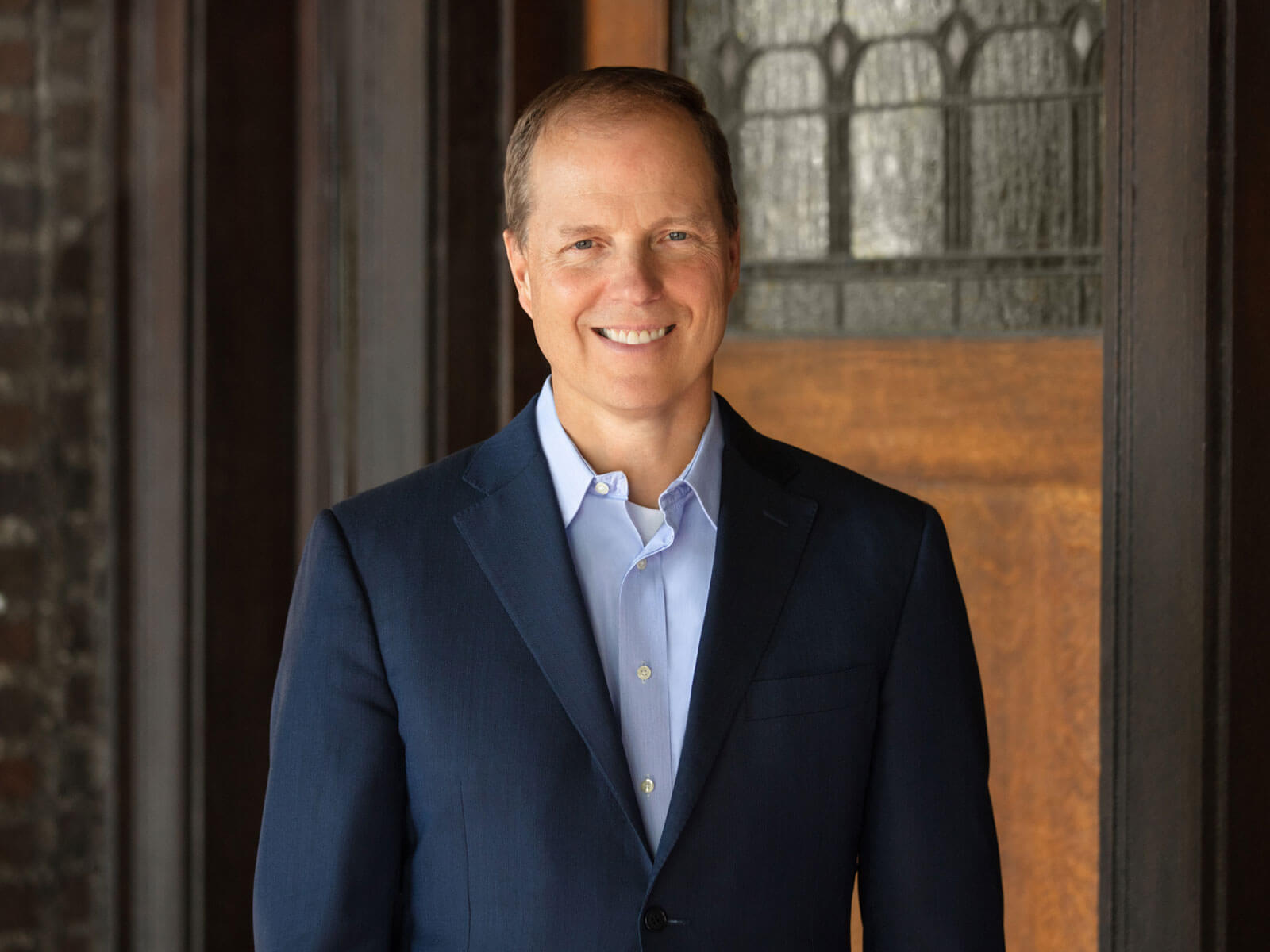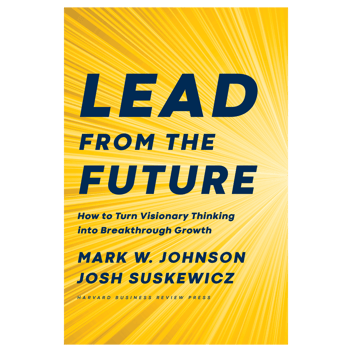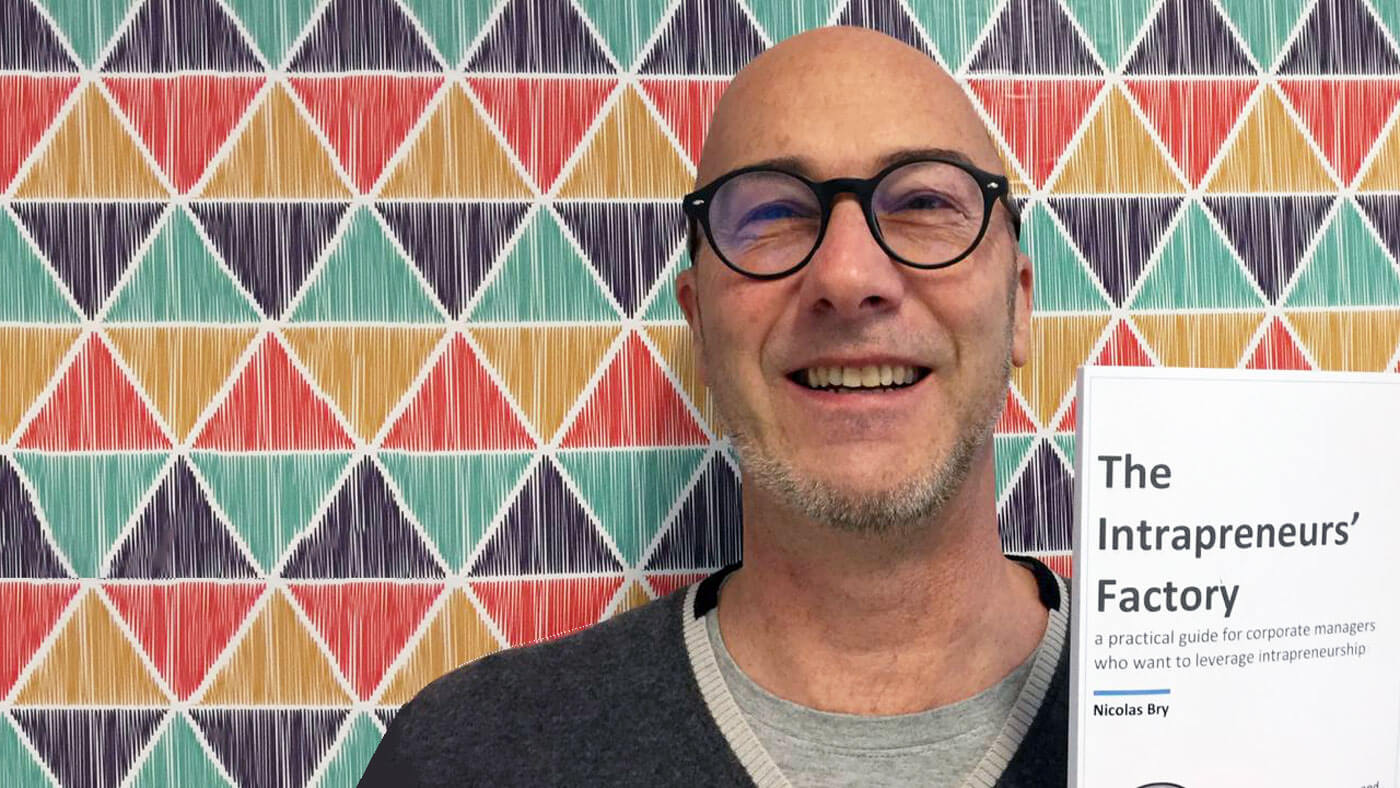Future-Back Thinking For Leading Innovation with Mark Johnson
I recently had the opportunity to have a chat with Mark Johnson, the co-founder of Innosight and author of the new book Lead from the Future: How to Turn Visionary Thinking Into Breakthrough Growth.
In this in-depth interview Mark shares the story behind his new book going back to the beginnings of Innosight nearly 20 years ago.
We also cover other topics, such as what the common traits of successful leadership teams are, what advice Mark would give to innovators who are frustrated with their managers' inability to "get innovation", and how leaders should approach innovation in times of crisis like the one we're currently experiencing.
This interview is also available as an audio version on our new podcast, The Innovation Room, as well as on YouTube. I hope you'll enjoy the discussion!
Jesse
Mark, thanks for taking the time to do this! It’s really an honor to have the opportunity.
Before we get started, I’d like to offer my condolences on the passing of your co-founder Clay Christensen. He’s obviously been a huge inspiration for me throughout the years so I can only imagine how that’s impacted you and everyone else who knew him well.
Mark
Oh, yes, thank you. It's a big loss for him to have passed away. This has led to a lot of reflection about all the contributions he’s made to so many people and to me personally, and not just professionally.
It’s now been roughly a month since his passing and I’m now left with a deep gratitude for the kind of human being he was. His intellect, his generosity, and kindness have just been amazing.
And, you know, we hope to continue on in his legacy with what we do at Innosight.
Jesse
Certainly, the positive side of it is that that he was able to put a lot of his thoughts in writing, as well as teach and help so many people throughout the years that I'm sure his legacy will live on stronger than ever. Let's do our best to honor that.
Mark
Absolutely!
1. So, before we get started, could you please give a quick recap for those of our listeners who aren’t yet familiar with you or your work?
Sure. I’m Mark Johnson and I co-founded Innosight, a strategy and innovation consulting firm, with Clay Christensen about 20 years ago.
We started based on his work of the innovator's dilemma and disruptive innovation and were focused on helping companies not only deal with the threat of disruptive technologies and innovation, but also on how to turn it into an opportunity for new growth. Over these 20 years, we've evolved to not just think about breakthrough and disruptive innovation, but also how it connects to long-term strategy and leadership. We also work with leaders on how to behave up top to be able to drive breakthrough growth and support their innovation teams.
Over these 20 years, we've evolved to not just think about breakthrough and disruptive innovation, but also how it connects to long-term strategy and leadership. We also work with leaders on how to behave up top to be able to drive breakthrough growth and support their innovation teams.
And, you know, we put together the disciplines of innovation, strategy and leadership, with the companies and other institutions, not just for profit companies, that we help become the next version of themselves and own their futures.
We've been at it for about 20 years, and we've covered a gamut of industries. We haven't really focused on one particular, but we have focused on this idea of trying to help companies transform, navigate the future, and to continue to drive top line growth.
We find so often that the innovation teams get stood up and everybody's passionate about innovation, and they hire a chief innovation officer and and yet you don't necessarily see behavioral change at the top with the senior leadership team, and they need to be partners with the innovation teams efforts.
I'm sure we'll talk about that more today, but that's a key part of this: how do you get the leadership teams to be more innovative and more learning based, since they ultimately are the ones that are going to allocate the resources. So, if they're not onboard, it's not going to happen.
2. You have a new book coming out soon called “Lead from the Future: How to Turn Visionary Thinking Into Breakthrough Growth”. Could you share what it’s about?
Mark
Sure. The main idea of the book is that so many organizations, and not just businesses but governments, nonprofits, even religious institutions and large corporations, they're very good at planning, what we would call the short term, relatively speaking: budgeting and forecasting, and so on.
But it's forecasting off of the core business. So they're good up to the three year, maybe four year horizon. Beyond that, going into the real longer term, they’re not so good, and really not even interested.
We make an argument that says, if you really want to sustain the kind of growth that not only drives shareholder value but drives real purpose and motivation for the organization, you have to both plan for the short term and the long term.
The way that the long term has meaning is to go past a vision statement. That can be done by thinking in a different way, with an approach that we call future-back.
So, in a nutshell, what the book’s really about is being able to embrace the long term and the short term through both a way of thinking, and a process we call future-back.
 We try to do it both from a high-level inspirational side of things, but also try to get practical about how would you actually move through the process to be able to understand the future and do something about it.
We try to do it both from a high-level inspirational side of things, but also try to get practical about how would you actually move through the process to be able to understand the future and do something about it.
Jesse
Could you share how you’ve developed the approach that you talk about in the book?
Mark
Sure. It kind of goes back to the story of Innosight and who I am.
You know, we started in this innovation space, you know, and in the beginning it was mostly about disruptive innovation.
And then what is really the underpinning disruption is business model innovation. Often the disruption is in the business model and not in the technology.
I actually wrote a Harvard Business Review article called Reinventing Your Business Model, and then a book called Seizing the White Space and a follow-on book called Reinvent Your Business Model.
And so we focused on business model innovation amongst others and realized that often these efforts weren’t being successful and coming to fruition.
That got us into the recognition that without a strategy that could encompass the longer term process to incubate and accelerate new business models, they weren't gonna be successful.
That then got us into strategy and realizing that the nature of the strategy making process had to be much more learning based, more entrepreneurial, similar to what an innovation team would do with the business model.
That got us into developing a way of thinking called future-back as the means to overlay on these innovation efforts. The leadership piece then became about getting the leadership teams engaged in the right way of this strategic planning process to be able to support breakthrough innovation.
So, long story short, this has developed over almost 20 years.
It started with understanding innovation and breakthrough innovation. You know, classic disruptive innovation, and that led to the need for strategy and strategy making and that further evolved to the importance of vision as part of that and vision as viewed by leadership teams.
When putting all those pieces together, as we describe in the book, it’s the holistic part of it that I think makes it essential.
Without the strategy connected to the innovation and the leadership teams participating heavily in the strategy, we find that really companies trying to get beyond their core business are going to struggle unless they integrate these things together.
3. I’ve had the opportunity to read the book and I certainly appreciate the way you’ve created a holistic framework for thinking about the topic, bringing it from the very abstract to tangible.
If you had to pick one thing, what’s the message you’d like a reader to walk away with after they’re done with the book?
I think that I’d put it into two messages.
One is that there's a lot of, how should I put it, suspicion or skepticism about the idea of thinking 5 to 10 years down.
I mean, it's often viewed as a fool's errand. With all the noise and the complexity about today and how fast things are changing, even in the next couple of years, how could you even be looking out past two years, let alone 5 to 10?
I'm just here to tell, having done this many times with clients, that thinking out into the future and forming a vision and converting that to strategy and walking it back to inform better the kinds of seeds that you would plant today for the future, not just continuing to drive the core, which of course is essential, is eminently doable.
There is a way to bring the future and learn from it, embrace it and be able to shape it. It's not some kind of, again, fool's errand. It is actually manageable, and it should be part of management, and in fact it's more important than ever. The more complicated, the crazier things get, the faster things move, the more important it is to set aside time to look into the future and spend time in it.
So, I think that would be the main takeaway.
The secondary one is that in order to do that and to actually make it happen, we have to change the way we as leaders and managers think, because we're so consumed with so many things on our plates that we only think in a more ”execute & operate” way, even in innovation.
Leaders especially are still really working through product development and other kinds of innovation efforts in an execute & operate way. We have to step back and be more learning, exploring and discovery oriented.
We have to think in this different way if we're going to bring the future alive, and that, I think, is what I would hope to give readers.
The big insight over these last 20 years really is the importance of the 5 to 10-year horizon and how to bring it alive.
4. In your experience, where do you see most companies struggling on that axis from a vision to execution? Are there are any common patterns or is it always dependent on the situation?
Mark
I would say the one area where it's almost universally a struggle, in the case of doing something that's pretty transformative for the organization, is trying to go from vision to strategy to execution without really, as I talk about in the book programming the strategy.
Programming what was first started as vision and being able to really set up the right governance structure and the right processes and the right kind of team structure to be able to embark on initiatives in the right way is something we almost always see break down.
Companies are too anxious to go and say: ”Oh, we've got this inspiring vision and strategy and this is how we're going to do things”, and then just continue “we're really good at execution”. So they’ll just go and execute it in a similar way to how they execute on the product and the manufacturing line, salesforce and so forth.
So, I would say both as another important insight to take away from what we write about but that also constantly breaks down is this need to create this bridge from an inspiring vision and strategy to executing.
You have to have the in-between step of programming the strategy and spending the time to set up the organization, the governance, the process, and the structure in the right way.
– Mark Johnson
You have to have this in-between step of programming the strategy and really spending the time to set up the organization and the governance and the process and the structure in the right way. That's probably the number one part where companies, to your point, struggle: this vision to execution process.
Jesse
Could we dive a little deeper there? Are there any general ”good practices” that you'd recommend organizations take when they’re building that process?
Mark
Absolutely. We talk about it as understanding that it’s about developing a system as the approach to execution. It's not just a one thing.
And, as we talk about in the book, we don't give a very specific ”You got to do this, this and this” method, but what we try to do is give the main ingredients for achieving that. As mentioned before, it's very important that in addition to the Innovation team, the leadership team be engaged in the right way.
So their role is to set a proper governance, which means that they are overseeing major innovation efforts and that they are intimately involved and part of the process to help sponsor and support the efforts along the way.
The other role of a senior leadership team is setting up what we call a Transformation Management Office that there is actually, you know, some ongoing work in terms of being able to coordinate and manage, if you will, a work plan. That then ties into having overall master plan and funding. So they really have to kind of set up that one part of program.
Then the other thing is: How do you set up the organizational model for the innovation teams? That's covered more in other books, but it includes things like, how do you set up the right incubator for something that's gonna require a business model innovation effort, what the venture teams look like and what's the nature of the talent that needs to go on there?
So, in a nutshell, you know the programming piece needs to have the role of the senior leadership team and the right organizational model for the innovation teams. Then finally, what they both, the Innovation team and the leadership team, shepherd is a process and that process is, not even like a stage-gate product development process.
It needs to be much more, ”learn and discover, exploring, envisioning, being able to test and learn” approach. So, setting up the right kind of learning process for both of these teams are the ingredients, if you will, in terms of how it actually gets prescribed.
It definitely varies depending on the company, but that programming piece is what enables the leadership team and the innovation team to support each other around a process that's going to see these breakthrough initiatives through in the right way over time.
5. If you look at the leadership teams that you’ve seen to be more successful in innovation than others, are there are any specific patterns or traits that you see these teams having?
Absolutely. If you're looking back in time today, you can rely on data and analysis.
But when you're moving forward, with data being a reflection of the past, you have to be more oriented towards assumptions.
And being able to, as a leadership team, work around assumptions as opposed to just stated facts, requires the ability to embrace the abstract and some ambiguity. It requires a humility to be willing to be open to divergent point of views and to learn from others. We like to say that learning is on the other side of innovation, and then humility is on the other side of learning.
Learning is on the other side of innovation, humility is on the other side of learning.
– Mark Johnson
So, we find the best leadership teams are those that can come together and talk about these issues. The sum of them is greater than the individual pieces, needless to say. They work in a very collaborative way, and they're willing to diverge before they converge. It's that ability to learn from each other, to be open to subject matter experts, to be able to wrestle and iterate that creates success in a team.
By the way, that doesn't obviously mean that they're doing it even the majority of their time. But when they are looking toward the future and they are looking towards innovation teams that are working on new and different types of efforts that they are willing to step back and enter into the space of learning.
You know, I think a great example of being able to drive, you know a sort of the next version of yourself and sort of get to the next stage is what CEO Satya Nadella did at Microsoft.
It wasn't long into his tenure that his wife inspired him with the book Mindset, which helped him realize that they had become a culture of know-it-alls and needed to become a culture of learn-it-alls. It really inspired the organization to become much more open to learning and on being a learning organization, which helped move Microsoft to the next level under his leadership.
I think that's a great example of why I think it’s so important for leadership teams in the age that we live in, to have the ability, not all the time, but again a portion of their time, to be very open, to explore and envision, discover and to engage in a learning process that's probably going to be a little less comfortable for them, but is going to allow them to generate insights they wouldn't have if they didn't go through that kind of a learning effort.
6. Many of the people we work with aren’t often in a position where they can influence the vision or the strategy of their organization, yet they’re still tasked with “making innovation happen” in whatever organizational sandbox they happen to be in, which often leaves them quite frustrated. What advice would you give these people?
That's a great question! I've seen it happen myself with folks that are working in innovation teams. And you know, if the senior leaders are doing something different and they don't get it, that makes it really hard.
If they don't get it at all, and don't want to get it ever, then I don't really have much advice that I could give. I think it's just going to continually be frustrating, and at some point, maybe it's going to be untenable.
But what I could say, though, is for many organizations where maybe the leadership team isn't quite there yet, in terms of having developed the right vision or strategy, or being very inspirational, is being able to get them to start with the language.
What we've tried to do in the book is tell that there is a way of thinking called future-back versus the way of thinking traditionally present forward.
Having an opportunity to be able to just share the language with the folks that are your leaders and encourage seeing if you can influence them that way can often times be pretty powerful.
When Clay Christensen came out with the Innovator's Dilemma, it generated interest within Intel Corporation at a middle manager level. It got them very excited and concerned about what they were doing in terms of their innovation efforts in microprocessors.
It ultimately reached the desk of the CEO Andy Grove with their influence, who then read Innovator's Dilemma and it clicked for him as to what potentially could happen to Intel. That then led to something that had initially been generated bottom-up, to all of a sudden be moved in a much more top down way.
So, I think the question is, how can you give your boss, or the senior leaders above you a common language. If they're open to reading or hearing about a different way of thinking, that's a great start because then that language hopefully then moves to action.
And like I said, absent their openness to talk about a different language, I think it might be very hard to sustain in that business, especially if you're passionate about innovation and doing things in a different way.
7. What kind of challenges or opportunities are you personally most excited about at the moment, especially in light of the recent events related to COVID-19?
Mark
Well, you know, I can't help but be taken over by the coronavirus, like so many of us around the entire world. To your point, Jesse, it is an incredible challenge, and it's pretty scary.
I don't think we've ever experienced anything like how disruptive this is to our lives just in the day to day, and to what's happening with economies around the world, and just a lot of uncertainty going forward.
I would argue that, for so many countries and individuals, it's been a very present forward type of response, and not to criticize that because we are in a crisis, but I think it also lends the opportunity to recognize how disruptive this has been so we need to prepare for there to be potentially a next pandemic, and maybe it can happen sooner rather than later.
So, how would you future-back another one and actually have more thinking about what's the ultimate outcome that you want and how you would work backwards from there to the kinds of things you would have prepared today and that you could stage in a more prescribed way than the sort of reactive nature that we've seen pretty much around the world.
And I think this pandemic makes the idea of leading from the future, and the future-back thinking approach and this work even more compelling and clear. I'm excited to see institutions hopefully embrace this way of thinking. And like I said, it's not just business but other organizations too.
We talk about leaders burning the furniture to heat their homes, they're so stuck in the short term and it's only getting worse as the complexity of things just becomes greater. If they can spend time setting plans further out for the things that could face nations and the world.
The other big one is global warming. At least in the United States under this government, maybe less so in other places, we’re very present-forward, very transactional.
It's all about “what can we do to boost the economy now?”. Global warming seems so far out in terms of its impact that there's not a lot of looking out 30 years and working backwards to what should be done today, five years from now and so forth to make an impact.
I see these things as major threats, but also opportunities. Just as we described in the book, unless you spend time out 5, 10 or maybe more years, you oftentimes don't see completely the opportunities and the threats you would, had you spent time there. And more importantly, the implications and what to do about it.
So, I would take some of these major, literal disruptions like pandemics and future disruptions, like global warming, as case study number one and number two of what you can do today.
But, don't do today in just a reaction. Plan out and say, “How do you shape that future? How do you anticipate it?”. Then, what are the things you would do today to work towards wanting to become better about managing future pandemics?
Jesse
Absolutely, even though the crisis is obviously a terrible situation for so many, it can also serve as the catalyst for the change that we need to make going forward.
There’s an old saying: “Don’t let a good crisis go to waste”.
Mark
Exactly! I think we can again, in the spirit of humility is on the other side of learning and learning is on the other side of innovation, think about what can we learn after we've gotten past all the immediate steps we have to do to try to, as we've been calling it here in the United States, flatten the spike in the curve of those that are infected with COVID-19.
When things at some point settle down, and they will, what can we learn from this? How could we be better next time to anticipate and to be more future oriented towards things that can really hurt us, or that can really be opportunities and to be able to have more things in place to prepare for those future unseen events?
8. Any other recommendations or closing thoughts for our listeners who are looking to make more innovation happen in their own organizations?
Well, again, it's just worth repeating that if you're looking to make innovation happen in the sense of not just incremental, but to really drive new market-creating innovation, to be able to get your organization to continue to drive the core as much you can, but be able to get beyond the core, then I encourage the open-mindedness and the faith that the 5-10 year horizon is eminently manageable.
It can create incredible insights that lead to choices that you would make today that otherwise you wouldn't be aware of to make or wouldn't have the same commitment behind if you didn't have this long-term view.
I just encourage to literally try to cajole and give language about the 5-10-year horizon, like we talk about in the book.
Software companies that are moving super-fast, maybe their horizon stretches from 3 to 5. Companies in longer term industries, like in defence or in pharmaceuticals, maybe it's even greater than 5-10. The 5-10 is almost like a metaphor for “uncomfortably long-term” that stretches you.
I would just encourage them to read the book Lead from the Future to give them the language and approach, but then try to embed that in their organization.
This longer-term planning horizon is essential, especially, and somewhat counterintuitively, as things move even faster and there's more noise in the here and now, the more important it is to carve out time and embrace this longer-term horizon and really plan for it as we're experiencing today with this current crisis around the world.
Jesse
Fully agree! The book is a great read, so I would certainly recommend our listeners to pick that up once it’s available.
Mark
Yes, it's scheduled for April 14th as we speak, but just like so many other things, it's possible that it might be delayed a month to May but we're taking this one day at a time.
Jesse
Great, thanks again for your time Mark, it’s been a real pleasure! I wish you and the new book all the success.
Mark
Well, thank you, Jesse. It's been my honor to be on your show.

Interested in Innovation and Leadership?
Subscribe to our blog and join the 40k+ other innovators who read our latest stories on innovation, leadership and culture every month.




